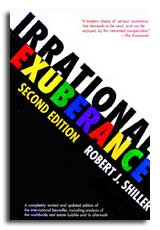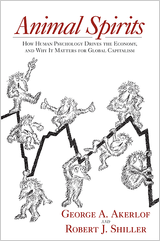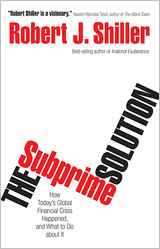This post was created and posted in real-time, before the talk was even concluded. For a more detailed article on the same talk see the UWO Law website.
People will always act rationally, right?
That’s the assumption upon which we rest our economic decisions, and one which Dr. Robert Shiller of Yale University is questioning.
Shiller is one of the world’s most well-known economists, and a bestelling author. Several weeks ago, he received the 2009 Deutsche Bank Prize in Financial Economics.
 He predicted the 2000 IT bubble burst in the first edition of his book, Irrational Exuberance.
He predicted the 2000 IT bubble burst in the first edition of his book, Irrational Exuberance.
But he also predicted the 2005 housing crisis in his second edition, and outlined a recover plan in Subprime Solution: How the Global Financial Crisis Happened and What To Do About It.
He has a new book though, co-authored with Nobel Prize winner George Akerlof, on Animal Spirits: How Human Psychology Drives the Economy, and Why It Matters for Global Capitalism.
It was this most recent book that was the topic of his talk at the University of Western Ontario on March 27, 2009. He was working on this book for six years, but decided to released it now given the current economic situation.
John Keynes once said in 1936, in General Theory of Employment Interest and Money,
The outstanding fact is the extreme precarious of the basis of knowledge on whic our estimates of prespective yield have to be made… Most probably, our decisions to do something positive, the full consequences of which will be drawn out over many days to come, can only be take as a result of animal spirits – of a spontaneous urge to action rather than inaction.
 Nobody can predict the future. There are many people who pretend that they can, however.
Nobody can predict the future. There are many people who pretend that they can, however.
Most actions are affected by what people anticipate will happen, and it’s in these animal spirits that we see the root of this economic crisis.
Postponing building new factories or laying off people leads to another round of problems; they are unable to spend, they tell others of their experiences, and there are ripple effects.
As a result we get into a period of lost opportunity.
Animal spirits are contrary to the thinking of economics, who always want to look to something concrete like the central bank, but it’s usually the animal spirits that drive things.
Real cycle business theory believes that all the drivers of the economy is technological change. Although there is some validity to this like the railroads, it doesn’t explain things like the changes we see today.
A Theory of Animal Spirits
- Confidence and Its Multipliers:Â Non-economists talk about this all the time.
- Fairness:Â There are other aspects of human thinking that change over time. and people get angry when they feel the are being treated unfairly as with the AIG bonuses.
- Corruption and Bad Faith:Â These things make a situation even worse when they increase.
- Money Illusion:Â Change in money supply.
- Stories: The human mind tends to be built around stories, particularly human interest stories. Our mind constructs a narrative of the economy that dictates our confidence.
A Case Study of Three Countries
A review of the stock market confidence index shows that the recent changes are unique in American history. The only similar patter is the Roaring 20’s, but on a much smaller scale.
People ask, “What happened in 1929,” and nobody can isolate it other than an unsustainable euphoria.
If looking at price-earnings ration, there is no theory that finance people have to explain the big changes in the 20’s and the present.
The Depression parallel is very important, not because we’re going to have another depression, but because there are a lot of similar things that are going to happen.
He put together for the first time a 100 year indext of US home prices from 1890 to 2008, and it shows that the recent bubble is the biggest in American history. People were worried that home prices were rising so fast that they had to buy one now or it would be too expensive for them in the future.
This is a story that spooked everyone, like a Gold Rush.
It was not dirven by population, building costs, or immigration rates.
Story of Japan
Japan is quite different because it boomed until the last day of 1999, and since has been 20 years of dropping.
So much for stocks in the long-run.
The early period was one of Japanese euphoria, one that had to come to an end. People say the Bank of Japan did it by tightened credit, but that wouldn’t have been enough to do this.
In comparing US and Japanese institutional investors, he found that the average answers were much more optimistic about the Nikkei Index, while the rest of the world was skeptical.
The housing market in Japan peaked around the same time as the stock bubble, followed by 15 years of consecutive drop. Despite a small recovery recently, it’s likely to drop further given the economy.
This more recent story is different – it’s a world story, and Japan is being pulled along in this crisis.
Canada’s Story
Canada is awfully similar to the U.S. for consumer price index and real stock prices.
But the real estate market is slightly different. In comparing data from Prof. Tsur Somerville of UBC, there has been volatility in Canada. Vancouver it seems is the most volatile, and the 1980’s crash is one of the most dramatic he’s ever seen.
In comparing the Real Teranet 6-City Canada Home Price Index, it does seem that there is a bubble in Canada.
Need for International Coordinated Response to Crisis
In leading into the G20 meeting in London in early April, world leaders will be discussing the global crisis. This might be the most protested meeting in recent history, because the level of anger has ridden so high.
This is a world problem, and if any one country tries to deal with this on its own it will not be able to do it.
People are worried about protectionist measures – and countries might view each other as part of the problem. But people forget that other countries retaliate, and it’s not good for international relations either.
The first thing that needs to be done is fiscal targeting, defecit spending on a bigger scale than what has been seen so far.
The U.S. has passed $787 billion, but the unemployment rate is still predicted to drop 8% in 2010.
Canada’s $40 billion federal stimulus plan, but it probably won’t be enough. People are not worried about this crisis to take enough measures.
When we let this happen and come in late with a package it damages our psyche, even for a lifetime. Stop it before people lose their jobs, and tell their stories about the injustice that has happened to them.
Back in the bottom of the Depression, the one thing people were doing without was Mayonaise. When Miracle Whip was produced, it was the cheap alternative to Mayonaise. But we’re still buying the Depression product, even though the tough times ended.
People continue their established patterns of behaviour, even when the impetus behind them have passed.
We also need normal lending. The U.S. Federal Reserve has created Temer Auction Facility (TAF) and Term Asset Backed Securities Lending Facility (TALF), and set funds rate and nearly zero, just like in Japan.
The Bank of Canada, although more secure, has target for overnight rate of 0.5%, but this still isn’t enough.
These concerns should be addressed immediately before the confidence is threatened.
It’s also important not to forget justice for the forgotten and the struggling people.
In the U.S., there is a Homeowners Affordability and Stability Plan of $275 billion for struggling homeowners. As many as 25,00 Canadian subprime borrowers may lose their homes, and these lenders are asking Ottawa for help.
 It’s not their fault that these people who lose their jobs can no longer afford their mortgage installments. And this is something that should be kept in the forefront of our minds. Our sense of justice is intricately related to the sense of confidence.
It’s not their fault that these people who lose their jobs can no longer afford their mortgage installments. And this is something that should be kept in the forefront of our minds. Our sense of justice is intricately related to the sense of confidence.
The recent Tent City in Sacramento where nearly 2000 people are staying is an example of this. Something must be done.

